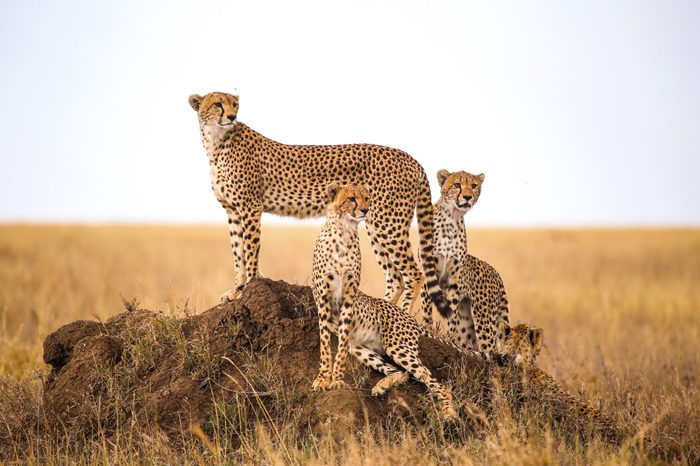
The big problems facing these big cats
Cheetahs—the spotted African cats with the distinctive black “tear tracks” that frame their faces—are famous for their ability to run fast. They’re not yet famous for their severely reduced population, but they should be, along with these 14 wild animal species you never knew were endangered. In 1900, the world’s cheetah population was thought to be 100,000 strong, but the Cheetah Conservation Fund Canada estimates that only 7,100 of the long-legged cats remain today. This is half as many as lived in the wild in 1975, according to TheConversation.com. Read on to find out what happened to these beautiful animals and to see what you can do to help them.
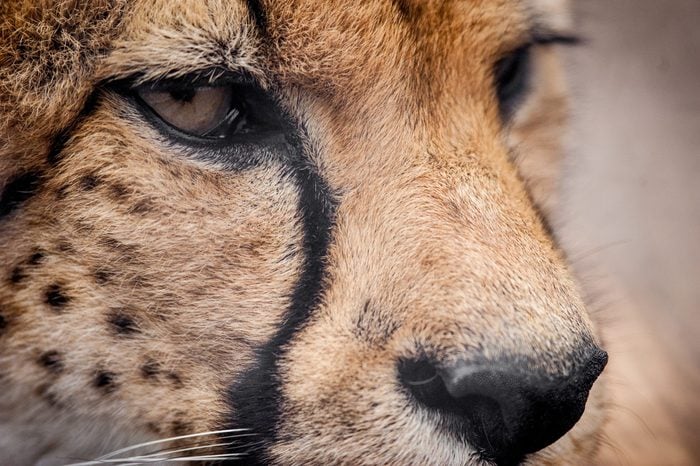
How do cheetahs differ from the other big cats?
Cheetahs are the smallest of the big cats, but they’re the most endangered. They’re different from lions, leopards, jaguars, and tigers in several ways. For example, cheetahs’ footpads are harder and they have blunter claws—kind of like the cleats that a soccer player wears—to help them run faster, according to the African Wildlife Foundation. Cheetahs also have long paddle-like tails, essential for the sharp, fast turns they make while hunting. It’s easy to differentiate between a leopard and a cheetah, though both have spots. Just look for the black “tear track” stripes that start at a cheetah’s eyes and end at its mouth. Which other big cats are at risk? These 6 endangered tiger species.
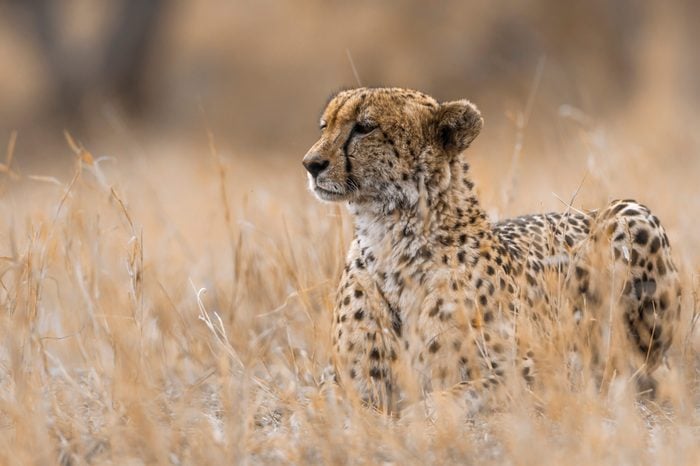
Habitat loss creates serious issues
As with most wild animals throughout the world, habitat loss is one of the biggest threats to cheetahs. As human cities and their populations continue to grow, previously wildland is used for farming, factories, resource development, and housing. Cheetahs and other wildlife are pushed into areas that are less and less able to provide for their needs. Habitat loss is also a key reason why 8 of the most endangered elephants in the world are threatened.
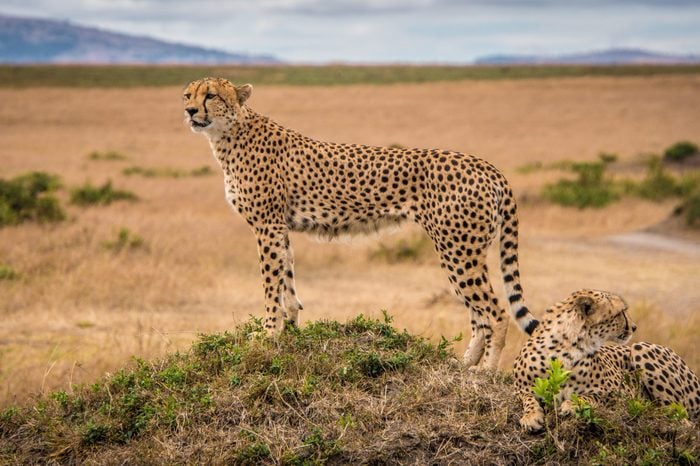
Where do wild cheetahs live?
Cheetahs once lived throughout almost all of the African continent, on the Arabian Peninsula, and into Asia as far east as India. The African Wildlife Foundation reports that cheetah territory is now only 10 percent of what it once was. The largest remaining cheetah range is in southern Africa in countries like Botswana, Namibia, South Africa, and Zimbabwe. Some live in eastern Africa, too. You can see them in protected areas like Uganda’s Kidepo Valley National Park, at Kenya’s Cottar’s 1920s Camp, and at two cheetah rehabilitation centers near Durban in South Africa’s KwaZulu-Natal province.
According to Science Daily, the Saharan cheetah is very close to extinction. The Zoological Society of London estimates that just 250 remain in countries like Niger and Algeria, while Mongabay reports that perhaps only 50 Asiatic cheetahs remain in Iran. While this is distressing, it is possible to turn things around—and these 11 endangered baby animals making a comeback will give you hope for the world.

Their food supply is shrinking
Cheetahs mainly eat antelopes like gazelles, says the Conservation Institute. The habitat and population of antelopes are also shrinking, and this means a reduced food supply for carnivorous predators like cheetahs. A cheetah eats a gazelle every few days, though a mother with young cubs needs to bring one home for dinner daily.
According to Macroevolution.net, cheetahs hunt by bringing on a burst of their famous speed once they’re within about 100 yards of their prey. But their success rate isn’t great, and cheetahs need to rest frequently between sprints. When they do finally catch dinner, cheetahs need to eat quickly or hide it because other carnivores like hyenas and lions often steal from cheetahs. Here are 60 interesting facts about animals you probably don’t know.
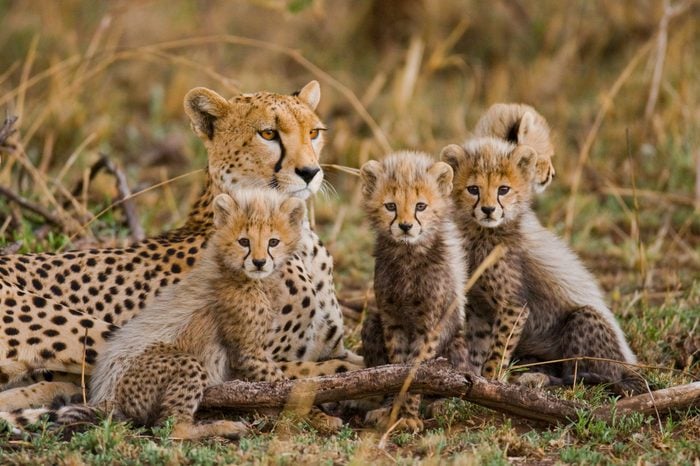
Cheetahs have high infant mortality rates
Many baby cheetahs don’t make it past their first birthday. Generally only three cubs per litter—which can have as many as eight cubs—survive. Like most baby animals, cheetah cubs are prey to other carnivores. Cheetah mamas raise their cubs alone, and it’s hard for them to keep everyone safe and fed.
Cheetah cubs do have a line of defense though. According to Lion World Travel, the fluffy gray coat of young cheetahs (called a mantle) not only makes them look bigger and stronger, it also makes young cubs resemble honey badgers. The honey badger is small but ferocious, and it can release a nasty smell like a skunk. Dubbed by Guinness as “the world’s most fearless animal,” it’s one of these 22 animal species so gross, they’ll make your skin crawl. Most predators, even hungry ones, are wise enough to leave animals like skunks and honey badgers alone.
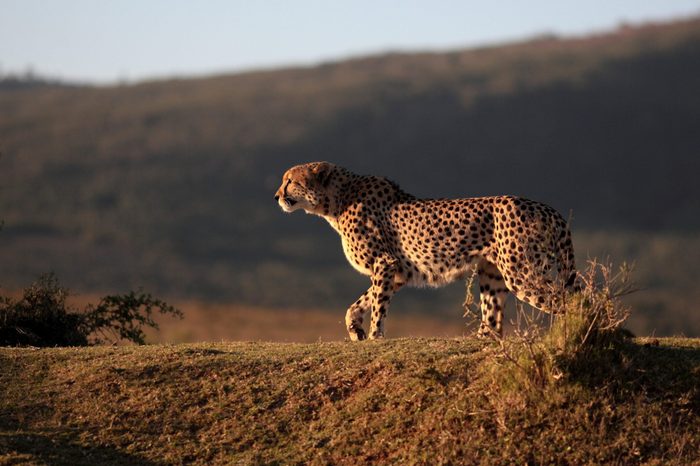
Human predators are their biggest threat
In the 1970s and ’80s, the cheetah population was drastically reduced by 75 percent, according to the African Wildlife Foundation. Farmers, believing cheetahs were a threat to their livestock and game herds, killed them. Now, foundations like AfriCat help farmers erect better fences to protect their animals and provide education on how wildlife conservation is beneficial to everyone.
But humans are a threat in many ways. The Association of Zoos and Aquariums reports that cheetahs are illegally poached so they can be kept as “status” pets (on purpose, not like these “pets” that tuned out to be wild animals). However, many young cheetahs die during the process, and if they survive to become pets at all, most die within the first two years. Trophy hunters also continue to hunt cheetahs for sport and to display their hides.
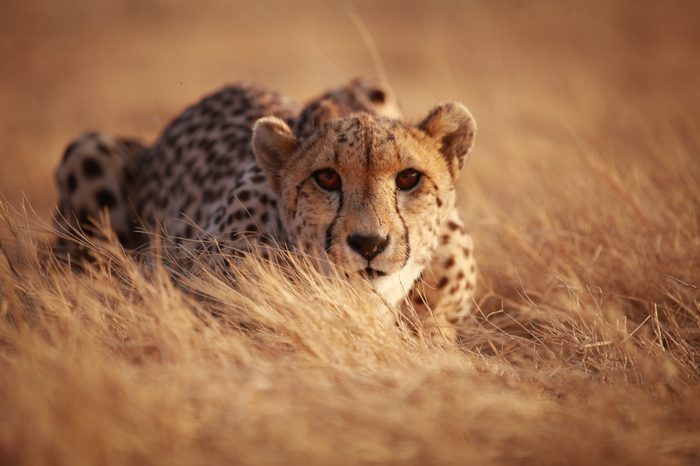
How can we help cheetahs?
Tourism, when done responsibly, supports the protection of wildlife. When you visit a reserve that rescues and rehabilitates cheetahs and rereleases them into the wild, your tourism dollars contribute to protecting endangered species. You also help build an economy that supports healthy wildlife that is worth more alive and protected.
One example is the AfriCat Foundation in Namibia. According to Montecristo Magazine, the foundation has done a lot to save cats like cheetahs (including rescuing and rehabilitating them) and educate farmers to prevent cheetahs from being mistakenly labeled and killed as nuisance predators. Tourists can get a close look at cheetahs by joining rangers on safari at Okonjima Nature Reserve as they check to make sure orphaned cheetahs that have been taught how to hunt are thriving. You can volunteer to help cheetahs, too. Check out these 16 incredible animals that came back from the brink of extinction.
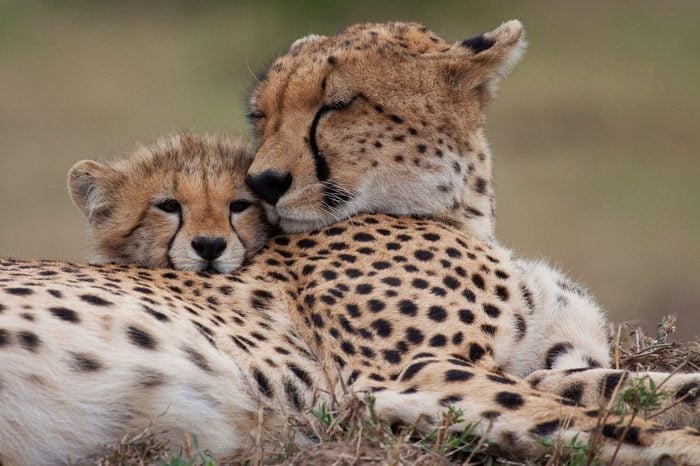
How can we help in the United States?
Organizations like the Cheetah Conservation Fund and AfriCat Foundation accept donations to support their work. You can even sponsor a cheetah. Raising awareness of the threats to cheetahs—for example, by sharing information and articles like this—can also make a big difference. Similarly, admiring cheetahs at AZA-accredited zoos like Orlando’s Central Florida Zoo and the Living Desert Zoo in Palm Desert, California, helps, as well. Next, find out how many rhinos are left in the world.
